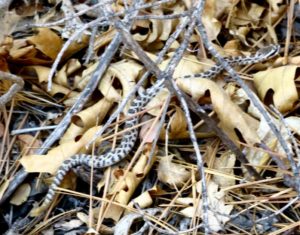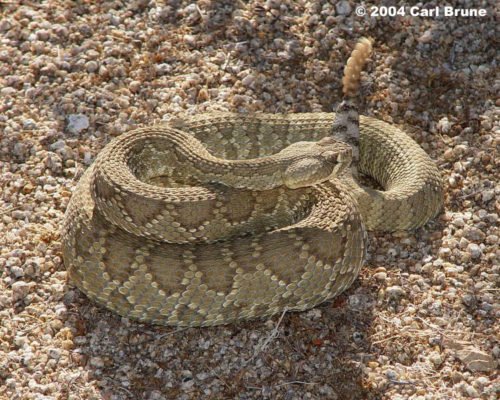My posts on rattlesnakes and rattlesnake relocation are my most-read articles. Some popular ones are Debunking Rattlesnake Myths, Relocating Rattlesnakes, and More on Relocating Rattlesnakes, and of course Rattlesnake training for dogs.
My go-to rattlesnake expert, Dr. William Hayes of Loma Linda University, answered the following questions. These were posed by Joann Mitcham, a reader in So CA who relocates rattlesnakes while continually trying to educate her fellow homeowners on not killing them.
If you call Animal Control will they kill the snake?

Dr. Hayes: Some cities have their own Animal Control, but usually this service is provided by the county. By policy, most animal control officers are going to kill the snake. And they’ll do it by one of the most cruel means available: decapitation. I wish we could educate them to do things differently; I once spoke at length with officials at the main Riverside County facility, but nothing has changed there, to my knowledge.
By policy, most animal control officers are going to kill the snake. And they’ll do it by one of the most cruel means available: decapitation. – Dr. William Hayes
Is there any kind of repellent to place around the property that would work?
Dr. Hayes: I’m extremely skeptical that any of the products sold actually work. There are no available data to suggest otherwise.
Is the Mojave Green around this area and the worst of the worst?

Dr. Hayes: The Mojave (Green) Rattlesnake is not in your area, Joann; it’s not even close. In California, it’s restricted to the Mojave Desert north of the Transverse Mountains (San Gabriel and San Bernardino ranges, extending eastward through Joshua Tree National Park). Their venom is different than that of the other species in our region, and is indeed more toxic in mice (see answer to next question), but the antivenom is very effective against it. In fact, the predominant antivenom sold in the U.S. (CroFab) is made by injecting minute quantities of the venoms from four snake species into sheep, and then harmlessly harvesting the antibodies from the sheep’s blood. The four species are Mojave Rattlesnake, Western Diamond-backed Rattlesnake, Eastern Diamond-backed Rattlesnake, and Cottonmouth. Thus, many of the antibodies in the medication are specific to the Mojave Rattlesnake’s somewhat unique venom.
Do they have venom differences (neurotoxin vs other)?
Dr. Hayes: All rattlesnakes have complex venoms with up to 100 or more distinct protein toxins. The two major rattlesnake venom phenotypes (the proper word) can be summarized as proteolytic (type I or type B in the literature) and neurotoxic (type II or type A in the literature). Proteolytic venoms are highly digestive in nature, rich with proteolytic enzymes that degrade animal tissues, causing severe local and systemic tissue injury. Neurotoxic venoms are much less digestive, but cause severe systemic problems by impairing the cardiovascular, respiratory, and gastrointestinal systems. The proteolytic venoms are more widespread within our vipers. In southern California we see the neurotoxic venoms only in the Mojave Rattlesnake and within a small portion of the range of the Southern Pacific Rattlesnake (the San Jacinto Mountains). The neurotoxic venoms have greater lethality when administered in small doses to mice, but, again, we have antivenom that neutralizes the venom very effectively.
Why is the Red Rattlesnake a protected species?
Dr. Hayes: Bad information; although I think all animals should be protected from harm, it really should not be protected by the state’s legal apparatus. Much of the snake’s southern California habitat has been bulldozed and otherwise altered, which has justified the classification, but there are a TON of snakes in the remaining habitat, and they are not at all threatened with extirpation in our region.
Maybe there is a good book (or booklet) somewhere that can be distributed?
Hayes: There really is not a good general book about rattlesnakes specific to southern California. I wish there was one. I wish I had more time to produce one myself.
Want more education on rattlesnakes? Every September Hayes gives a full-day course on snakes of the desert at the Desert Institute in Joshua Tree National Park every September. This year, it’s scheduled for September 29. There is a fee to enroll in the course, Much of the course focuses on rattlesnakes, their venom, and snakebite. Hayes said the course consistently draws a large audience, so it might be good to sign up sooner rather than later.
Joann and I are also helping set up some rattlesnake talks for Dr. Hayes so people can learn first-hand from an expert. Please contact Dr. Hayes ([email protected] or leave a message at 909-558-4530) if you live in So California and are interested in setting up a talk.
Six Species in Southern California
Also, since there’s considerable confusion, here are the six rattlesnakes that are found in Southern California: Red Diamond, Mojave, Western Diamond-backed, Sidewinder, Southern Pacific and Speckled. Dr. Hayes shared a powerpoint with me about these six that I would be glad to forward to anyone. Write me at [email protected]
Do cats get bit also or just dogs ?
They certainly can but my understanding is it’s far less common because they are much quicker (and probably less curious than the average dog)